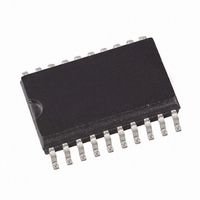ATA8204P3-TKQY Atmel, ATA8204P3-TKQY Datasheet - Page 11

ATA8204P3-TKQY
Manufacturer Part Number
ATA8204P3-TKQY
Description
IC RCVR ASK/FSK UHF 433MHZ 20SSO
Manufacturer
Atmel
Datasheet
1.ATA8203P3-TKQY.pdf
(46 pages)
Specifications of ATA8204P3-TKQY
Frequency
433MHz
Sensitivity
-115dBm
Data Rate - Maximum
10 kbps
Modulation Or Protocol
ASK, FSK
Applications
General Purpose
Current - Receiving
8.5mA
Data Interface
PCB, Surface Mount
Antenna Connector
PCB, Surface Mount
Features
RSSI Equipped
Voltage - Supply
4.5 V ~ 5.5 V
Operating Temperature
-40°C ~ 85°C
Package / Case
20-SOIC (0.200", 5.30mm Width)
Pin Count
20
Screening Level
Industrial
Lead Free Status / RoHS Status
Lead free / RoHS Compliant
Memory Size
-
Lead Free Status / Rohs Status
Compliant
8. Polling Mode
8.1
9121B–INDCO–04/09
Sleep Mode
The clock cycle of some function blocks depends on the selected baud-rate range (BR_Range),
which is defined in the OPMODE register. This clock cycle T
formulas:
BR_Range =
According to
three different modes. In sleep mode the signal processing circuitry is disabled for the time
period T
nal processing circuits are enabled and settled. In the following bit-check mode, the incoming
data stream is analyzed bit-by-bit and compared with a valid transmitter signal. If no valid signal
is present, the receiver is set back to sleep mode after the period T
according to each check as it is a statistical process. An average value for T
electrical characteristics. During T
condition of the receiver is indicated on pin IC_ACTIVE. The average current consumption in
polling mode is dependent on the duty cycle of the active mode and can be calculated as:
During T
reception of a transmitted command, the transmitter must start the telegram with an adequate
preburst. The required length of the preburst depends on the polling parameters T
T
depends on the actual bit rate and the number of bits (N
The following formula indicates how to calculate the preburst length.
T
The length of period T
sion factor X
calculated to be:
T
The maximum value of T
2 ms in that case. The sleep time can be extended to almost half a second by setting X
X
Setting the configuration word Sleep to its maximal value puts the receiver into a permanent
sleep mode. The receiver remains in this state until another value for Sleep is programmed into
the OPMODE register. This is particularily useful when several devices share a single data line.
(It can also be used for microcontroller polling: using pin POLLING/_ON, the receiver can be
switched on and off.)
I
Spoll
Preburst
Sleep
Bit-check
Sleep
= Sleep
=
can be set to 8 by bit X
Sleep
I
--------------------------------------------------------------------------------------------------------------- -
Sleep
and the start-up time of a connected microcontroller, T
Soff
T
Sleep
while consuming low current of I
Figure 8-1 on page
Sleep
and T
T
+ T
T
Sleep
X
Sleep
Sleep
(according to
Startup
Startup
+
Sleep
+
I
Son
T
, the receiver is not sensitive to a transmitter signal. To guarantee the
+ T
1024
Sleep
Startup
is defined by the 5-bit word Sleep of the OPMODE register, the exten-
Bit-check
SleepStd
BR_Range0:
BR_Range1:
BR_Range2:
BR_Range3:
is about 60 ms if X
T
+
Startup
Table 11-8 on page
T
12, the receiver stays in polling mode in a continuous cycle of
T
Clk
Startup
+ T
Bit-check
to “1”.
Start_microcontroller
+
and T
T
ATA8203/ATA8204/ATA8205
Bit-check
S
Bit-check
= I
Soff
Sleep
. During the start-up period, T
, the current consumption is I
27), and the basic clock cycle T
T
T
T
T
is set to 1. The time resolution is about
Bit-check
XClk
XClk
XClk
XClk
= 8
= 4
= 2
= 1
) to be tested.
XClk
Start_microcontroller
T
T
T
T
Clk
Clk
Clk
Clk
is defined by the following
Bit-check
Bitcheck
. This period varies
. Thus, T
is given in the
Startup
Sleep
S
= I
Sleep
, T
Son
, all sig-
Clk
Bit-check
Startup
. It is
. The
to 8.
11
,












